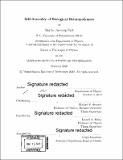| dc.contributor.advisor | Michael P. Brenner and Leonid A. Mirny. | en_US |
| dc.contributor.author | Falk, Martin Jin-teng. | en_US |
| dc.contributor.other | Massachusetts Institute of Technology. Department of Physics. | en_US |
| dc.date.accessioned | 2020-11-03T20:30:56Z | |
| dc.date.available | 2020-11-03T20:30:56Z | |
| dc.date.copyright | 2020 | en_US |
| dc.date.issued | 2020 | en_US |
| dc.identifier.uri | https://hdl.handle.net/1721.1/128325 | |
| dc.description | Thesis: Ph. D., Massachusetts Institute of Technology, Department of Physics, February, 2020 | en_US |
| dc.description | Cataloged from PDF version of thesis. | en_US |
| dc.description | Includes bibliographical references (pages 115-122). | en_US |
| dc.description.abstract | In this thesis, we are primarily concerned with understanding the complicated geometrical and topological structures that polymers can adopt. We first consider this in the context of chromatin, the polymer of DNA and associated proteins. Our experiments and coarse-grained modeling suggest that attractions between heterochromatic regions are central to the separation of the active and inactive genome in nuclei. We adopt a similar strategy of coarse-grained polymer modeling in order to devise a collagen-like scheme for twisting polymers together. We found that such scheme generically includes the presence of defects, which we speculate could be useful in designing hierarchical assemblies of twisted filaments. In order to extend strategies for twisting of filaments to arbitrary braid topologies, we constructed a simple numerical model for a device that manipulates float-attached wires with capillary interactions between the walls of the device and the float. We use this model to rationalize design rules for the device, and to predict the motion of the float in non-trivial geometries. Finally, we study the dynamics of a two-dimensional seven-particle cluster as it relaxes from an extended, polymer-like state. We find that this system rarely reaches its (non-degenerate) global free energy minimum. | en_US |
| dc.description.statementofresponsibility | by Martin Jin-teng Falk. | en_US |
| dc.format.extent | 122 pages | en_US |
| dc.language.iso | eng | en_US |
| dc.publisher | Massachusetts Institute of Technology | en_US |
| dc.rights | MIT theses may be protected by copyright. Please reuse MIT thesis content according to the MIT Libraries Permissions Policy, which is available through the URL provided. | en_US |
| dc.rights.uri | http://dspace.mit.edu/handle/1721.1/7582 | en_US |
| dc.subject | Physics. | en_US |
| dc.title | Self-assembly of biological heteropolymers | en_US |
| dc.type | Thesis | en_US |
| dc.description.degree | Ph. D. | en_US |
| dc.contributor.department | Massachusetts Institute of Technology. Department of Physics | en_US |
| dc.identifier.oclc | 1201521709 | en_US |
| dc.description.collection | Ph.D. Massachusetts Institute of Technology, Department of Physics | en_US |
| dspace.imported | 2020-11-03T20:30:52Z | en_US |
| mit.thesis.degree | Doctoral | en_US |
| mit.thesis.department | Phys | en_US |
